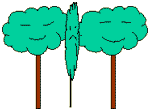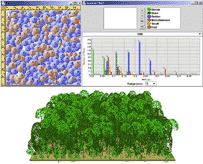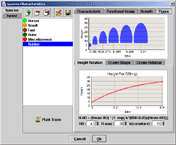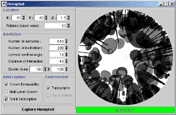 The SExI Forest Simulator focuses on tree-tree interactions in a
mixed multi-species agroforest. The high level of structural
complexity of such traditional agroforestry systems defies
classical forestry approaches when it comes to optimizing
management practices. To cope with this complexity, farmers have
adopted a tree-by-tree management approach, which is closer to
gardening than to any usual tropical forestry or estate crop
management model. Individual tree care and regular tending takes
the form of seedlings transplanting, selective cleaning and
felling, adjusted harvesting intensity.
The SExI Forest Simulator focuses on tree-tree interactions in a
mixed multi-species agroforest. The high level of structural
complexity of such traditional agroforestry systems defies
classical forestry approaches when it comes to optimizing
management practices. To cope with this complexity, farmers have
adopted a tree-by-tree management approach, which is closer to
gardening than to any usual tropical forestry or estate crop
management model. Individual tree care and regular tending takes
the form of seedlings transplanting, selective cleaning and
felling, adjusted harvesting intensity.
 Farmers' approach appears to be in line with two basic tenets of biology:
first, individuals are all different with behavior and
physiology that result from a unique combination of genetic and
environmental influence, and second, interactions are inherently
local. Based on the same premises a computer model was developed
to explore different management scenarios.
Farmers' approach appears to be in line with two basic tenets of biology:
first, individuals are all different with behavior and
physiology that result from a unique combination of genetic and
environmental influence, and second, interactions are inherently
local. Based on the same premises a computer model was developed
to explore different management scenarios.
The model uses an object-oriented approach where each tree is
represented by an instance of a generic class of tree. The
simulated object trees, mimicking real trees, interact through
modifying their neighbors' environment. These modifications are
mediated through two major resources: space and light. A 3D
representation of a one-hectare plot of forest serves as the
grounds for the simulation of this competition.
Read more..

What's new?
| 12-02-2007 |
SExI-FS Documentation version 2 is available. The new software will be uploaded soon. |
| 24-06-2005 |
SExI-FS website is updated!
The updates including the new SExI-FS
1.0.200506 software, Documentations and User's
Guide.
|
| 12-05-2005 |
The first training on the SExI-FS model currently
developed in ICRAF SEA. Participants came from various
institutions and places (4 from ICRAF Jambi, 2 from ICRAF-Kalimantan,
1 from PSU Thailand, 3 ICRAF Bogor, 5 from IRRI Sembawa). |
| 12-07-2004: |
The new
version of SExI-FS will be soon released with the new
crown development model (STReTCH model).
please contact us
if you would need to be informed about the
release. |
| 12-07-2004: |
 The
STReTCH Model Poster has been presented in the 4TH International Workshop on Functional-Structural Plant Models
(FSPM), 07-11 June 2004, Montpellier, France. The
STReTCH Model Poster has been presented in the 4TH International Workshop on Functional-Structural Plant Models
(FSPM), 07-11 June 2004, Montpellier, France.
The STReTCH model (Shape Transformation Response of Trees in Crowded Habitat)
is a generic crown development model for multi-species forest stand
modeling.
Click
here to see more..
|
| 29-07-2002: |
SExI-FS 1.0 beta2 version is available
for download!
Bug Fixed : The trees which are loaded from a saved
forest didn't show in 3D visualization. |
|
24-07-2002:
|
3D
Virtual Branch is available on the web. It's a tool for
visualize tree branch data in 3D.
|
About SExI-FS
Result Examples

Rubber Monoculture plantation shows a predominantly regular distribution of
tree size. The effect of border (more light) causing the tree to grow a bit
faster.
More..
|
 Rubber Agroforest shows a wide distribution of sizes due to dynamic
competition of a mixed multi-species and species specific growth rates.
Rubber Agroforest shows a wide distribution of sizes due to dynamic
competition of a mixed multi-species and species specific growth rates.
More..
|
Parameters
|
 The parameters are divided into two categories, the plot level
parameters and species sensitive parameters.
Each species has its own set of growth parameters and morpho-physiological characteristics.
The parameters are divided into two categories, the plot level
parameters and species sensitive parameters.
Each species has its own set of growth parameters and morpho-physiological characteristics.
More..
|
3D Visualization
|
 The stand can be explored using a 3D viewer. Pseudo leaves (randomly oriented
triangles) are spread over tree crown envelopes mimicking foliage. Broken or
degraded crowns (CF < 5) may be identified as they show incomplete foliage
coverage of crown envelope.
The stand can be explored using a 3D viewer. Pseudo leaves (randomly oriented
triangles) are spread over tree crown envelopes mimicking foliage. Broken or
degraded crowns (CF < 5) may be identified as they show incomplete foliage
coverage of crown envelope.
More..
|
How does it's work?
|

Potential diameter increment of each tree is calculated using the first
derivation of Chapman-Richards function ( ). Actual growth
is then derived from this calculation after addition of other environmental
effects and species sensitive response. ). Actual growth
is then derived from this calculation after addition of other environmental
effects and species sensitive response.
More..
|
Others
STReTCH
|
 The STReTCH model (Shape Transformation Response of Trees in Crowded Habitat)
is a generic crown development model for multi-species forest stand
modeling.
The STReTCH model (Shape Transformation Response of Trees in Crowded Habitat)
is a generic crown development model for multi-species forest stand
modeling.
More..
|
Simple Light Interception Model (SLIM)
 The purpose of the SLIM software is to compute canopy closure (an index of
long term light level) at any height above the ground within a forest canopy.
It was initially developed as a module of this dynamic forest growth model
(SExI-FS).
The purpose of the SLIM software is to compute canopy closure (an index of
long term light level) at any height above the ground within a forest canopy.
It was initially developed as a module of this dynamic forest growth model
(SExI-FS).
More..
 The SExI Forest Simulator focuses on tree-tree interactions in a
mixed multi-species agroforest. The high level of structural
complexity of such traditional agroforestry systems defies
classical forestry approaches when it comes to optimizing
management practices. To cope with this complexity, farmers have
adopted a tree-by-tree management approach, which is closer to
gardening than to any usual tropical forestry or estate crop
management model. Individual tree care and regular tending takes
the form of seedlings transplanting, selective cleaning and
felling, adjusted harvesting intensity.
The SExI Forest Simulator focuses on tree-tree interactions in a
mixed multi-species agroforest. The high level of structural
complexity of such traditional agroforestry systems defies
classical forestry approaches when it comes to optimizing
management practices. To cope with this complexity, farmers have
adopted a tree-by-tree management approach, which is closer to
gardening than to any usual tropical forestry or estate crop
management model. Individual tree care and regular tending takes
the form of seedlings transplanting, selective cleaning and
felling, adjusted harvesting intensity. Farmers' approach appears to be in line with two basic tenets of biology:
first, individuals are all different with behavior and
physiology that result from a unique combination of genetic and
environmental influence, and second, interactions are inherently
local. Based on the same premises a computer model was developed
to explore different management scenarios.
Farmers' approach appears to be in line with two basic tenets of biology:
first, individuals are all different with behavior and
physiology that result from a unique combination of genetic and
environmental influence, and second, interactions are inherently
local. Based on the same premises a computer model was developed
to explore different management scenarios.







